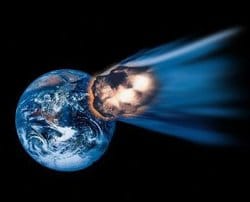
The first asteriod, christened 2010 RX30, was about 65 feet (20 metres) in diameter and flew past at a distance of 154,000 miles early at 9:51am on Wednesday.
The second, called 2010 RF12, was roughly two-thirds the size of its big brother and estimated to pass within just 49,088 miles of Earth hours later.
While they were visible to many amateur stargazers, space agency researchers said neither asteroid posed a risk to earth.
Experts, however, said the “double-whammy” served as a reminder of other potentially hazardous objects expected to narrowly miss Earth in coming years.
Nasa estimates that asteroids smaller than 25 metres in diameter would burn up while entering the atmosphere and cause no damage.
Scientists said while it was common to witness a single asteroid at such close range it was rare to see two make such close passes. Figures show about 50 million NEO’s (Near Earth Objects) pass by every day.
But what made this event so significant was that the two asteroids passed so close to Earth on the same day within hours of each other.
“This is the first time we’ve seen (two) combined within a 24-hour period but that’s probably because we don’t know everything that is out there,” said Lindley Johnson, program executive of the Near-Earth Object program at Nasa’s headquarters in Washington.
Donald Yeomans, another manager of the programme, which detects and tracks potentially hazardous asteroids and comets, said neither asteroid was visible to the naked eye.
He added that when they were nearest both asteroids were visible from moderate strength amateur telescopes.
In July, Nasa experts gave details of an asteroid measuring more than 600 yards wide, which has a one-in-a-thousand chance of colliding with Earth in 2182.
That collision promises to create more damage than that of the atomic bombing of Hiroshima.
Preceding this, Apophis, a 25 million ton celestial body will narrowly miss our planet three times in succession.
The first near-miss is expected on the superstitious date of Friday 13th 2029.
“I think this is Mother Nature’s way of firing a shot over the bow and warning Earth-based astronomers that we have a lot of work to do,” Dr Yeomans added.
by Robbo Green

